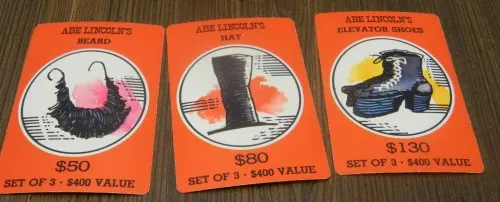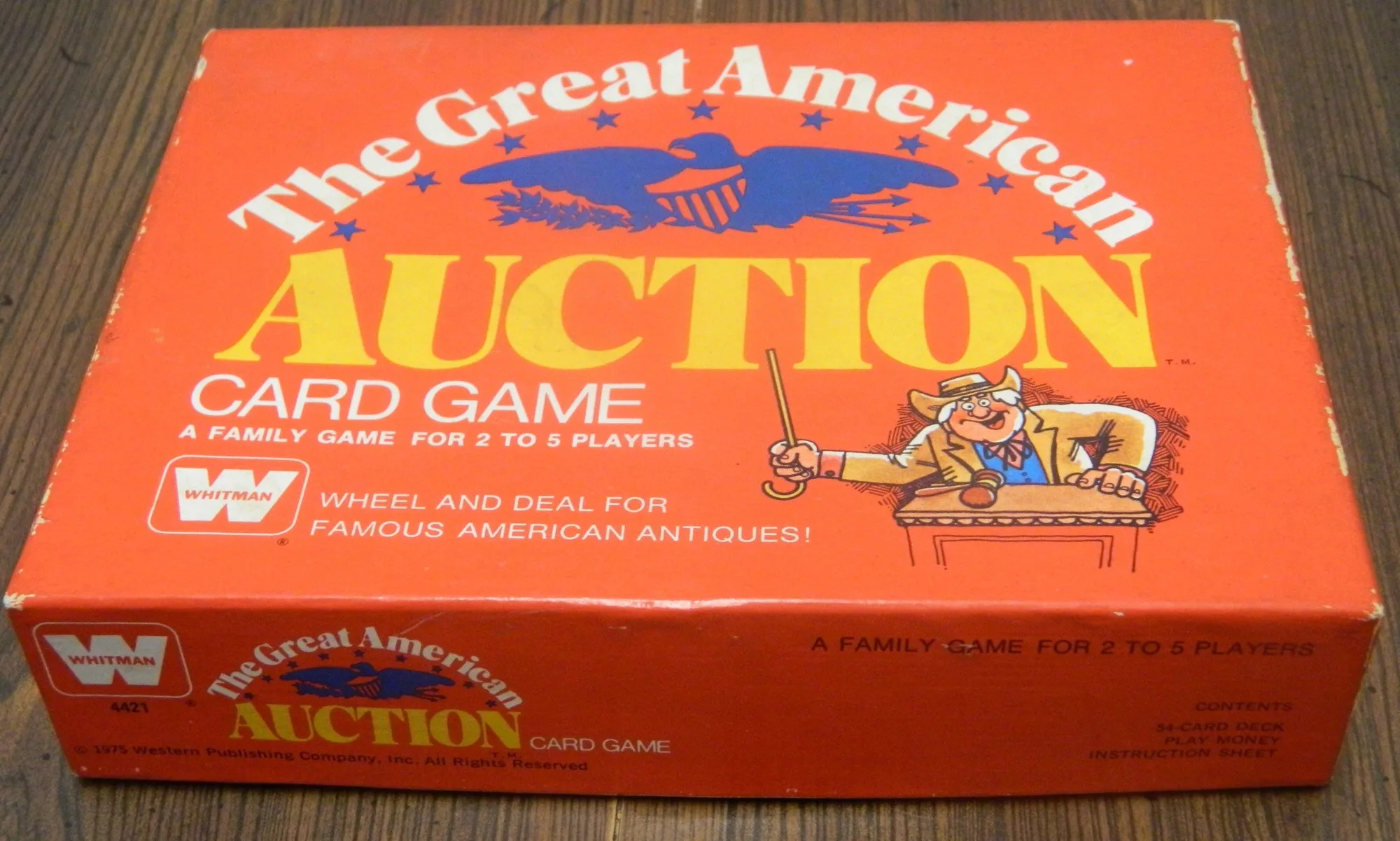How to Play
To begin the game every player gets the following money: 1-$500, 2-$100, 4-$50, 3-$20, 2-$10, and 4-$5. The three auction cards are removed from the deck of cards. The cards are then shuffled. Each player gets three cards and five cards are dealt face up in the center of the table. The three auction cards are then added back into the deck and the deck is shuffled again.
At the beginning of a players’ turn they first check if they have a full set of antiques from a famous American. The number of cards in each set is printed on the bottom of the cards. If a player has a complete set they can sell the set to the bank for the value stated at the bottom of the card. When the set is sold, the cards are removed from the game.

The player then has the option of buying as many of the face up cards as they want by paying the bank the asking price. If the player needs more money to purchase one of the cards they can sell any of the cards in their hand for half of the purchase price. Any cards sold this way are returned to the bottom of the deck so they can be purchased by another player in a future turn.

Before the next player’s turn, new cards from the deck replace the cards that were purchased. If all of the players pass on a set of five cards that are for sale, the five cards are returned to the deck and five new cards are put out.
If one of the cards put out is one of the auction cards, play is currently stopped for an auction round. All of the cards currently for sale are put up for auction (one at a time). Players bid for the item and the winner pays the bank the winning amount. The winner then gets to start the bidding for the next item for sale. If anyone ends up bidding more money than they can pay, they are penalized $200 and they can not bid on any more items during the current auction. If players need more money during the auction they can sell cards in their hand for half price. Once all of the cards that were for sale have been auctioned off, play returns to normal.Whoever bought the last item in the auction becomes the current player.
When the last antique card in the deck has been purchased players can try to trade, buy or sell cards with the other players. Once everyone is done trading the game ends. Each player adds up their wealth (cash, antiques that don’t comprise a set, antiques that complete a set). Whoever has the most wealth wins the game.
My Thoughts
The Great American Auction Card Game is a game made by Whitman in 1973. In the game all of the players are trying to accumulate sets of items from famous Americans to sell for a profit. The Great American Auction game tries to combine a card game with an auction/buying game. While not fantastic, The Great American Auction game is a solid card game.
The Great American Auction Card Game is first and foremost a set collection game. In order to make money you need to complete various sets of items. Except for buying items for really cheap in the auctions, this is the only way to make money in the game. Unlike most set collecting games where you need to get lucky and draw the cards that you need to complete a set, in The Great American Auction game players purchase/bid for the cards that they need to complete sets. Allowing you to purchase your cards reduces some of the luck typically found in set collection games.
Unfortunately the game still has quite a bit of luck to it. In order to be successful in the game you need to be lucky and have the cards that you need come up for sale (preferably during your turn). If you invest quite a bit of cash in a set and the final card of the set takes forever to show up for sale you will have less money to invest in new cards than the other players. If the card you need shows up during another player’s turn you also need to hope that they don’t know you need the card. If they know you need the card they are likely to buy it before you can.
This reliance on luck means that if you don’t have luck early in the game, your fortunes are unlikely to change. If you are unlucky early in the game, you end up having your money tied up in cards. Since you don’t have much money, you can’t really use your money to buy new cards. Having less cards means that it will be harder to get additional sets later in the game. You generally want to keep as many cards in your hand as you can afford.
On the other hand if you complete a lot of sets early in the game you can easily continue to build on your lead. In the game I played I was able to complete several sets early in the game. This gave me a lot of cash early in the game. With all of this cash I was able to buy up a lot of cards and a couple times bought up all of the cards that were available for sale. Since the cards are worth what you paid for them at the end of the game, I wasn’t really risking much since I could have either used the cards to complete sets or I would just get my money back at the end of the game. By buying all of the cards I also prevented other players from completing sets which kept me ahead in the game.
You need to be careful when you purchase cards though. You don’t want to buy too many cards that you don’t have any money to buy a card that you truly need. I actually almost ran into this problem. After completing several sets very early in the game, I bought up a lot of cards which didn’t complete sets. Due to holding all of these cards in my hand, I didn’t have a lot of money at the end of the game. I almost lost out on some of my sets because I barely had enough money to purchase the cards I needed.
To prevent a player from buying up a lot of cards, I think the game should have changed the rules to make the cards that you hold in your hand at the end of the game not worth their full purchase price. By having them worth their full purchase price, the only punishment for buying up a lot of cards is that you end up having a lot of money tied up in the cards. Instead of giving you the full value, I think the game should have given you around 75% of the purchase price for every item in your hand that is not part of a set.
The auction portion of the game is interesting. It adds an interesting twist to the normal gameplay and is a good addition. It allows players to take some of the luck out of the game. Instead of having to wait for an item to make it to their turn, a player can bid enough in order to make sure that they get the card. In some cases you might get quite a bargain at the auction or you might end up paying more than the item would normally sell for. Even though players can bid whatever they want, there is a range in which every item should sell for. The item should always sell for at least half the normal selling price since otherwise a player could just buy the card and sell it right away making a quick profit. On the other end of the spectrum, a card should not sell for more than the full set is worth since the player would just be losing money by buying the card.
Unfortunately the auction mechanic is kind of flawed. For example based on prior purchases, players start to get a good idea of what other players currently hold in the hands. If the last card you need for a set reaches the auction stage, you may be in trouble. If the other players know you need the card, they are likely to bid you up. You then need to make a decision of either paying what it takes to get the card or if you would rather save the money and let the other player have the card.
Finally I found the components to be below average. The cards are a little thin. The artwork is very simplistic and boring. The cards serve their purpose but they don’t really add to the theme at all. The cards are just pretty basic and could have been made quite a bit better. The play money is smaller than your typical play money but otherwise is fine. The card tray is made of a pretty thin plastic which will lead to tearing/cracking.
Final Verdict
Overall The Great American Auction Card Game is a very average card game. I actually had a decent amount of fun playing the game. It is the type of game that I would play occasionally. The problem is that the game doesn’t really do anything special. The game relies too heavily on luck. You can do a lot worse but there are also quite a few better card games that you could play.
If you don’t like these simpler card games you probably won’t like the Great American Auction Card Game. If the concept of the game sounds interesting to you though, I think you should have some fun playing the game.

